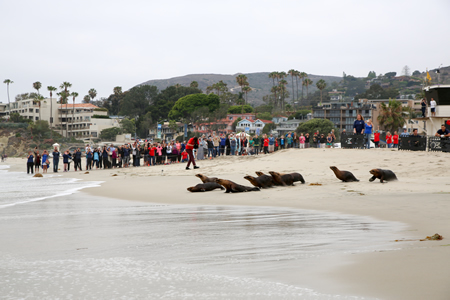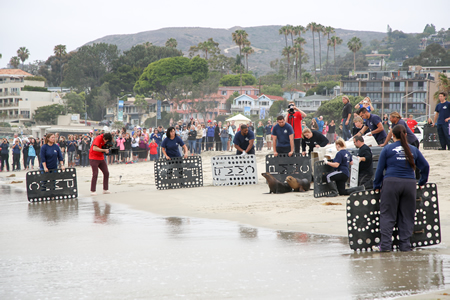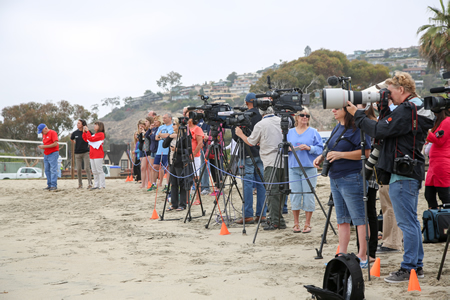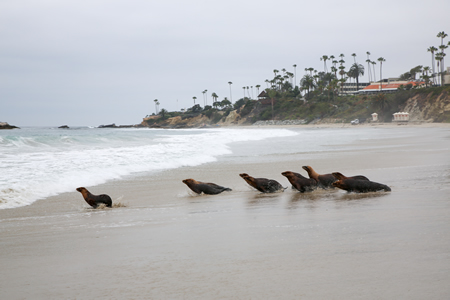
With an entourage of onlookers lining the sand, 14 of 17 sea lions injured by chlorine mysteriously dumped into a marine wildlife rehabilitation facility last month scampered from Main Beach back into their native habitat Tuesday.
The 14 sea lions released had all received medical clearance, while three others whose eyes also suffered ulcerations due to the chlorine spill need a few more weeks to heal, said Keith Matassa, executive director of the Pacific Marine Mammal Center in Laguna Beach, the only sea mammal rescue center in the county.
Investigators are still questioning past and present employees, theorizing that a disgruntled worker may have been responsible for dumping chlorine in one of the center’s pools and harming the animals recuperating, said Laguna Beach police Sgt. Tim Kleiser.
While police have not ruled out that the contamination could have been caused by an unintentional spill, the center’s own store of chlorine, dispersed from a tank into the water filtration system, was at normal levels when investigators arrived, Kleiser said. “To get to those high levels needed to lot of chlorine or to use concentrated chlorine,” he said.
On Tuesday, an initial group of 11 pups emerged from seven pens placed side-by-side 10 yards from the shoreline. Once they hit the water, the sea lion pack boisterously leaped above the water’s surface, known as “porpoising,” as if signaling the exuberance of liberation.

To coax out another three timid pups that failed to emerge, volunteers moved the pens closer to the waves. Even after they ventured onto the sand, the trio hesitated for several moments about returning to the wild. Volunteers cut off their path of retreat with hand-held barriers, herding them into the lapping sea.
“There are always a few reluctant ones,” said Council member Kelly Boyd, who has been on hand to observe other releases in Crescent Bay and joined Mayor Bob Whalen and Council member Rob Zur Schmiede to watch the great sea lion release.
Like parents at their children’s graduation, the center’s volunteers hugged each other, expressions of joy, relief and loss at seeing their charges disappear.
Passersby also briefly cheered from behind a barricade amid a phalanx of news reporters and photographers.

Among them was Beth Fox, of Pleasanton, Calif., who was in a swimming suit despite the early hour and the marine layer. On a week’s vacation, she stepped out to join an exercise class on the north end of Main Beach. “This looks more exciting than Laughing Yoga,” said Fox, who joined the onlookers.
A similar emotion energized Mattassa even though 100 animals remain under the center’s care, most of them, like the 14, malnourished pups rescued between Dana Point and Bolsa Chica beginning in January.
Some good resulted from the chlorine attach, which received international attention, Matassa said. The center’s staff received condolences and good wishes from across the globe, he said. And California lawmakers last week proposed harsher penalties for animal cruelty in the wake of the attack on the Laguna Beach center.
Even so, Matassa said the center is preparing for another wave of sick animals. Other centers are reporting strandings of sea lions suffering seizures, typically set off by sardines poisoned by demoic acid, a naturally occurring neurotoxin produced by algae.





[…] Police initially suspected someone with knowledge of the center’s filtration system intentionally harmed the animals and questioned former employees. The inquiry changed course once investigators analyzed the center’s water system and found a spike in chlorine levels on April 27, said Sgt. Tim Kleiser, the day before sea lions were discovered with ulcerated eyes due to chlorine poisoning. They have all since recovered. […]